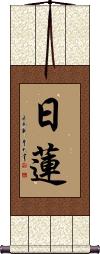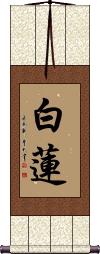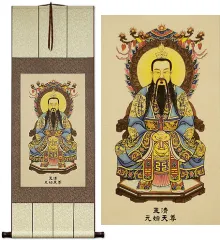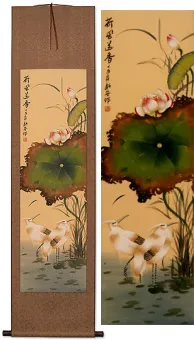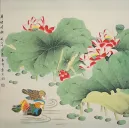Many custom options...
And formats...

The name Pure Lotus in Chinese / Japanese...
Buy a Pure Lotus calligraphy wall scroll here!
Personalize your custom “Pure Lotus” project by clicking the button next to your favorite “Pure Lotus” title below...
Nichiren
日蓮 is the title Nichiren.
This title refers to a Buddhist priest who lived from 1222 to 1282. He is the founder of the Nichiren sect of Buddhism.
According to historical documents, the Nichiren sect was established in 1252. Adding the character 宗 for sect, this would be 日蓮宗 (Nichiren sect), which is also known as the 法華宗 or Lotus sect.
According to Soothill-Hodous...
Nichiren's chief tenets are the three great mysteries 三大祕法, representing the trikāya:
1. 本尊 or chief object of worship, being the great maṇḍala of the worlds of the ten directions, or universe, i.e., the body or nirmāṇakāya of Buddha.
2. 題目 the title of the Lotus Sutra 妙法蓮華經 Myo-ho-ren-ge-kyo, preceded by Namo, or “Adoration to the scripture of the lotus of the wonderful law,” for it is Buddha's spiritual body.
3. 戒壇 the altar of the law, which is also the title of the Lotus as above; the believer, wherever he is, dwells in the Pure-land of calm light 寂光淨土, the saṃbhogakāya.
Wisdom Lotus
White Lotus
白蓮 is the title for the white lotus (flower) or a short name for the White Lotus society.
The white lotus represents purity or a pure heart and is often associated with Buddhism.
Notes: This can be the Japanese given name Byakuren. In the Buddhist context, the white lotus represented by these characters is originally puṇḍarīka in Sanskrit.
This in-stock artwork might be what you are looking for, and ships right away...
Gallery Price: $268.00
Your Price: $148.88
Gallery Price: $200.00
Your Price: $69.88
Gallery Price: $200.00
Your Price: $69.88
Gallery Price: $126.00
Your Price: $69.88
Gallery Price: $126.00
Your Price: $69.88
Gallery Price: $60.00
Your Price: $36.88
Gallery Price: $126.00
Your Price: $69.88
Gallery Price: $126.00
Your Price: $69.88
Gallery Price: $538.00
Your Price: $298.88
Gallery Price: $60.00
Your Price: $36.88
Not the results for pure lotus that you were looking for?
Below are some entries from our dictionary that may match your pure lotus search...
| Characters If shown, 2nd row is Simp. Chinese |
Pronunciation Romanization |
Simple Dictionary Definition |
日蓮 日莲 see styles |
rì lián ri4 lian2 jih lien nichiren にちれん |
More info & calligraphy: NichirenNichiren, the Japanese founder, in A. D. 1252, of the 日蓮宗 Nichiren sect, which is also known as the 法華宗 or Lotus sect. Its chief tenets are the three great mysteries 三大祕法, representing the trikāya: (1) 本尊 or chief object of worship, being the great maṇḍala of the worlds of the ten directions, or universe, i. e. the body or nirmāṇakāya of Buddha; (2) 題目 the title of the Lotus Sutra 妙法蓮華經 Myo-ho-ren-gwe-kyo, preceded by Namo, or, 'Adoration to the scripture of the lotus of the wonderful law, ' for it is Buddha's spiritual body; (3) 戒壇 the altar of the law, which is also the title of the Lotus as above; the believer, wherever he is, dwells in the Pure-land of calm light 寂光淨土, the saṃbhogakāya. |
白蓮 白莲 see styles |
bái lián bai2 lian2 pai lien byakuren びゃくれん |
More info & calligraphy: White Lotus(1) white lotus; (2) purity; pure heart; (given name) Byakuren (白蓮華); 分陀利 puṇḍarīka, the white lotus. |
妙蓮華 妙莲华 see styles |
miào lián huá miao4 lian2 hua2 miao lien hua myō renge |
More info & calligraphy: Wisdom Lotus |
淨土宗 净土宗 see styles |
jìng tǔ zōng jing4 tu3 zong1 ching t`u tsung ching tu tsung Jōdo Shū |
Pure Land Buddhism The Pure-land sect, whose chief tenet is salvation by faith in Amitābha; it is the popular cult in China, also in Japan, where it is the Jōdo sect; it is also called 蓮宗(蓮花宗) the Lotus sect. Established by Hui-yuan 慧遠 of the Chin dynasty (317— 419), it claims P'u-hsien 普賢 Samantabhadra as founder. Its seven chief textbooks are 無量淸淨平等覺經; 大阿彌陀經; 無量壽經; 觀無量壽經; 阿彌陀經; 稱讚淨土佛攝受經; and 鼓音聲三陀羅尼經. The淨土眞宗 is the Jōdo-Shin, or Shin sect of Japan. |
一蓮 一莲 see styles |
yī lián yi1 lian2 i lien ichiren いちれん |
(given name) Ichiren The Lotus-flower of the Pure-land of Amitābha, idem 蓮臺. |
三乘 see styles |
sān shèng san1 sheng4 san sheng minori みのり |
(surname) Minori Triyāna, the three vehicles, or conveyances which carry living beings across saṁsāra or mortality (births-and-deaths) to the shores of nirvāṇa. The three are styled 小,中, and 大. Sometimes the three vehicles are defined as 聲聞 Śrāvaka, that of the hearer or obedient disciple; 緣覺Pratyeka-buddha, that of the enlightened for self; these are described as 小乘 because the objective of both is personal salvation; the third is 菩薩Bodhisattva, or 大乘 Mahāyāna, because the objective is the salvation of all the living. The three are also depicted as 三車 three wains, drawn by a goat, a deer, an ox. The Lotus declares that the three are really the One Buddha-vehicle, which has been revealed in three expedient forms suited to his disciples' capacity, the Lotus Sūtra being the unifying, complete, and final exposition. The Three Vehicles are differently explained by different exponents, e.g. (1) Mahāyāna recognizes (a) Śrāvaka, called Hīnayāna, leading in longer or shorter periods to arhatship; (b) Pratyeka-buddha, called Madhyamayāna, leading after still longer or shorter periods to a Buddhahood ascetically attained and for self; (c) Bodhisattva, called Mahayana, leading after countless ages of self-sacrifce in saving others and progressive enlightenment to ultimate Buddhahood. (2) Hīnayāna is also described as possessing three vehicles 聲, 緣, 菩 or 小, 中, 大, the 小 and 中 conveying to personal salvation their devotees in ascetic dust and ashes and mental annihilation, the 大 leading to bodhi, or perfect enlightenment, and the Buddha's way. Further definitions of the Triyāna are: (3) True bodhisattva teaching for the 大; pratyeka-buddha without ignorant asceticism for the 中; and śrāvaka with ignorant asceticism for the 小. (4) (a) 一乘 The One-Vehicle which carries all to Buddhahood: of this the 華嚴 Hua-yen and 法華 Fa-hua are typical exponents; (b) 三乘法 the three-vehicle, containing practitioners of all three systems, as expounded in books of the 深密般若; (c) 小乘 the Hīnayāna pure and simple as seen in the 四阿合經 Four Āgamas. Śrāvakas are also described as hearers of the Four Truths and limited to that degree of development; they hear from the pratyeka-buddhas, who are enlightened in the Twelve Nidānas 因緣; the bodhisattvas make the 六度 or six forms of transmigration their field of sacrificial saving work, and of enlightenment. The Lotus Sūtra really treats the 三乘. Three Vehicles as 方便 or expedient ways, and offers a 佛乘 Buddha Vehicle as the inclusive and final vehicle. |
下品 see styles |
xià pǐn xia4 pin3 hsia p`in hsia pin gehin げひん |
(noun or adjectival noun) vulgar; indecent; coarse; crude; (place-name) Shimoshina The three lowest of the nine classes born in the Amitābha Pure Land, v. 無量壽經. These three lowest grades are (1) 下品上生 The highest of the three lowest classes who enter the Pure Land of Amitābha, i.e. those who have committed all sins except dishonouring the sūtras. If at the end of life the sinner clasps hands and says "Namo Amitābha", such a one will be born in His precious lake. (2) 下品中生 The middle class consists of those who have broken all the commandments, even stolen from monks and abused the law. If at death such a one hears of the great power of Amitābha, and assents with but a thought, he will be received into paradise. (3) 下品下生 The lowest class, because of their sins, should have fallen into the lowest gati, but by invoking the name of Amitābha, they can escape countless ages of reincarnation and suffering and on dying will behold a lotus flower like the sun, and, by the response of a single thought, will enter the Pure Land of Amitābha. |
中宗 see styles |
zhōng zōng zhong1 zong1 chung tsung nakamune なかむね |
(surname) Nakamune The school or principle of the mean, represented by the 法相宗 Dharmalakṣaṇa school, which divides the Buddha's teaching into three periods, the first in which he preached 有 existence, the second 空 non-existence, the third 中 neither, something 'between' or above them, e. g. a realm of pure spirit, vide the 深密經 Saṃdhinirmocana-sūtra and the Lotus Sutra. |
九品 see styles |
jiǔ pǐn jiu3 pin3 chiu p`in chiu pin kuhon; kokonoshina くほん; ここのしな |
(1) (abbreviation) {Buddh} (See 浄土・1) nine levels of Amitabha's Pure Land; (2) (くほん only) (See 九品浄土) Amitabha's Pure Land; (3) (くほん only) (See 九品蓮台) nine-tiered lotus leaf platform in Amitabha's Pure Land; (given name) Kuhon Nine classes, or grades, i.e. 上上, 上中, 上下 upper superior, middle superior, lower superior, and so on with 中 and 下. They are applied in many ways, e.g. 上品上生 the highest type of incarnate being, to 下品下生, the lowest, with corresponding karma; see 九品淨土. Each grade may also be subdivided into nine, thus making a list of eighty-one grades, with similar further subdivision ad infinitum. |
十二 see styles |
shí èr shi2 er4 shih erh tooji とおじ |
twelve; 12 12; twelve; (given name) Tooji dvātriṃśa. Thirty-two. 三十二應 (or 三十二身) The thirty-two forms of Guanyin, and of Puxian, ranging from that of a Buddha to that of a man, a maid, a rakṣas; similar to the thirty-three forms named in the Lotus Sūtra. 三十二相三十二大人相 dvātriṃśadvaralakṣaṇa. The thirty-two lakṣaṇas, or physical marks of a cakravartī, or 'wheel-king', especially of the Buddha, i. e. level feet, thousand-spoke wheel-sign on feet, long slender fingers, pliant hands and feet, toes and fingers finely webbed, full-sized heels, arched insteps, thighs like a royal stag, hands reaching below the knees well-retracted male organ, height and stretch of arms equal, every hair-root dark coloured, body hair graceful and curly, golden-hued body, a 10 ft. halo around him, soft smooth skin, the 七處, i. e. two soles, two palms, two shoulders, and crown well rounded, below the armpits well-filled, lion-shaped body, erect, full shoulders, forty teeth, teeth white even and close, the four canine teeth pure white, lion-jawed, saliva improving the taste of all food, tongue long and broad, voice deep and resonant, eyes deep blue, eyelashes like a royal bull, a white ūrnā or curl between the eyebrows emitting light, an uṣṇīṣa or fleshy protuberance on the crown. These are from the 三藏法數 48, with which the 智度論 4, 涅盤經 28, 中阿含經, 三十ニ相經 generally agree. The 無量義經 has a different list. 三十二相經 The eleventh chapter of the 阿含經. 三十二相經願 The twenty-first of Amitābha's vows, v. 無量壽經. 三十三 trayastriṃśat. Thirty-three. 三十三天忉利天; 憺梨天, 多羅夜登陵舍; 憺利夜登陵奢; 憺利耶憺利奢 Trayastriṃśas. The Indra heaven, the second of the six heavens of form. Its capital is situated on the summit of Mt. Sumeru, where Indra rules over his thirty-two devas, who reside on thirty-two peaks of Sumeru, eight in each of the four directons. Indra's capital is called 殊勝 Sudarśana, 喜見城 Joy-view city. Its people are a yojana in height, each one's clothing weighs 六鐵 (1; 4 oz. ), and they live 1, 000 years, a day and night being equal to 100 earthly years. Eitel says Indra's heaven 'tallies in all its details with the Svarga of Brahminic mythology' and suggests that 'the whole myth may have an astronomical meaning', or be connected, with 'the atmosphere with its phenomena, which strengthens Koeppen's hypothesis explaining the number thirty-three as referring to the eight Vasus, eleven Rudras, twelve Ādityas, and two Aśvins of Vedic mythology'. In his palace called Vaijayanta 'Indra is enthroned with 1, 000 eyes with four arms grasping the vajra. There he revels in numberless sensual pleasures together with his wife Śacī... and with 119, 000 concubines with whom he associates by means of transformation'.; dvādaśa, twelve. |
十宗 see styles |
shí zōng shi2 zong1 shih tsung jūshū |
The ten schools of Chinese Buddhism: I. The (1) 律宗 Vinaya-discipline, or 南山|; (2) 倶舍 Kośa, Abhidharma, or Reality (Sarvāstivādin) 有宗; (3) 成實宗 Satyasiddhi sect founded on this śāstra by Harivarman; (4) 三論宗 Mādhyamika or 性空宗; (5) 法華宗 Lotus, "Law-flower" or Tiantai 天台宗; (6) 華嚴Huayan or法性 or賢首宗; ( 7) 法相宗 Dharmalakṣana or 慈恩宗 founded on the唯識論 (8) 心宗 Ch'an or Zen, mind-only or intuitive, v. 禪宗 ; (9) 眞言宗 (Jap. Shingon) or esoteric 密宗 ; (10) 蓮宗 Amitābha-lotus or Pure Land (Jap. Jōdo) 淨士宗. The 2nd, 3rd, 4th, and 9th are found in Japan rather than in China, where they have ceased to be of importance. II. The Hua-yen has also ten divisions into ten schools of thought: (1) 我法倶有 the reality of self (or soul) and things, e.g. mind and matter; (2) 法有我無 the reality of things but not of soul; (3) 法無去來 things have neither creation nor destruction; (4) 現通假實 present things are both apparent and real; (5) 俗妄眞實 common or phenomenal ideas are wrong, fundamental reality is the only truth; (6) things are merely names; (7) all things are unreal 空; (8) the bhūtatathatā is not unreal; (9) phenomena and their perception are to be got rid of; (10) the perfect, all-inclusive, and complete teaching of the One Vehicle. III. There are two old Japanese divisions: 大乘律宗, 倶舎宗 , 成實 宗 , 法和宗 , 三論宗 , 天台宗 , 華嚴宗 , 眞言宗 , 小乘律宗 , and 淨土宗 ; the second list adds 禪宗 and omits 大乘律宗. They are the Ritsu, Kusha, Jōjitsu, Hossō, Sanron, Tendai, Kegon, Shingon, (Hīnayāna) Ritsu, and Jōdo; the addition being Zen. |
四法 see styles |
sì fǎ si4 fa3 ssu fa shihō |
There are several groups of four dharma: (1) 教法 the teaching of the Buddha); 理法 its principles, or meaning; 行法 its practice; 果法 its fruits or rewards. (2) Another group relates to bodhisattvas, their never losing the bodhi-mind, or the wisdom attained, or perseverance in progress, or the monastic forest life (āraṇyaka). (3) Also 信解行證 faith, discernment, performance, and assurance. (4) The Pure-land 'True' sect of Japan has a division: 教法, i. e. the 大無量壽經; 行法 the practice of the seventeenth of Amitābha's vows; 信法 faith in the eighteenth; and 證法 proof of the eleventh. The most important work of Shinran, the founder of the sect, is these four, i. e. 教行信證. (5) A 'Lotus ' division of 四法 is the answer to a question of Puxian (Samantabhadra) how the Lotus is to be possessed after the Buddha's demise, i. e. by thought (or protection) of the Buddhas; the cultivation of virtue; entry into correct dhyāna; and having a mind to save all creatures. |
宗派 see styles |
zōng pài zong1 pai4 tsung p`ai tsung pai shuuha / shuha しゅうは |
sect (1) sect; denomination; (2) school (e.g. of poetry) Sects (of Buddhism). In India, according to Chinese accounts, the two schools of Hīnayāna became divided into twentysects. Mahāyāna had two main schools, the Mādhyamika, ascribed to Nāgārjunaand Āryadeva about the second century A. D., and the Yogācārya, ascribed toAsaṅga and Vasubandhu in the fourth century A. D. In China thirteen sectswere founded: (1) 倶舍宗 Abhidharma or Kośa sect, representing Hīnayāna,based upon the Abhidharma-kosa-śāstra or 倶舍論. (2) 成實宗 Satyasiddhi sect, based on the 成實論 Satyasiddhi-śāstra,tr. by Kumārajīva; no sect corresponds to it in India; in China and Japan itbecame incorporated in the 三論宗. (3) 律宗 Vinaya or Discipline sect, basedon 十誦律, 四分律, 僧祗律, etc. (4) 三論宗 The three śāstra sect, based on theMādhyamika-śāstra 中觀論 of Nāgārjuna, theSata-śāstra 百論 of Āryadeva, and theDvādasa-nikāya-śāstra 十二門論 of Nāgārjuna; this schooldates back to the translation of the three śāstras by Kumārajīva in A. D. 409. (5) 涅槃宗 Nirvāṇasect, based upon the Mahāparinirvāṇa-sūtra 涅槃經 tr. byDharmaraksa in 423; later incorporated in Tiantai, with which it had much incommon. (6) 地論宗 Daśabhūmikā sect, based on Vasubandhu's work on the tenstages of the bodhisattva's path to Buddhahood, tr. by Bodhiruci 508,absorbed by the Avataṃsaka school, infra. (7) 淨土宗 Pure-land or Sukhāvatīsect, founded in China by Bodhiruci; its doctrine was salvation throughfaith in Amitābha into the Western Paradise. (8) 禪宗 dhyāna, meditative or intuitional sect, attributed toBodhidharma about A. D. 527, but it existed before he came to China. (9) 攝論宗, based upon the 攝大乘論 Mahāyāna-saṃparigraha-śāstra byAsaṅga, tr. by Paramārtha in 563, subsequently absorbed by the Avataṃsakasect. (10) 天台宗 Tiantai, based on the 法華經 SaddharmapuṇḍarīkaSūtra, or the Lotus of the Good Law; it is aconsummation of the Mādhyamika tradition. (11) 華嚴宗 Avataṃsaka sect, basedon the Buddhāvataṃsaka-sūtra, or Gandha-vyūha 華嚴經 tr. in 418. (12) 法相宗 Dharmalakṣaṇa sect, established after thereturn of Xuanzang from India and his trans. of the important Yogācāryaworks. (13) 眞言宗 Mantra sect, A. D. 716. In Japan twelve sects are named:Sanron, Hossō, Kegon, Kusha, Jōjitsu, Ritsu, Tendai, Shingon; these areknown as the ancient sects, the two last being styled mediaeval; therefollow the Zen and Jōdo; the remaining two are Shin and Nichiren; at presentthere are the Hossō, Kegon, Tendai, Shingon, Zen, Jōdo, Shin, and Nichirensects. |
淨眼 净眼 see styles |
jìng yǎn jing4 yan3 ching yen jōgen |
The clear or pure eyes that behold, with enlightened vision, things not only as they seem but in their reality. Also Vimalanetra, second son of Śubhavyūha in the Lotus Sutra. |
華目 华目 see styles |
huā mù hua1 mu4 hua mu kemoku |
Eyes like the blue lotus, i.e. pure. |
華胎 华胎 see styles |
huā tāi hua1 tai1 hua t`ai hua tai kedai |
The lotus womb in which doubters and those of little virtue are detained in semi-bliss for 500 years before they can be born into the Pure Land by the opening of the lotus. |
蓮宗 莲宗 see styles |
lián zōng lian2 zong1 lien tsung Renshū |
see 淨土宗|净土宗[Jing4 tu3 zong1] The Lotus sect founded by 慧遠 Huiyuan circa A.D. 390 at his monastery, in which was a 自蓮池 white lotus pond. It has no connection with the White Lily Secret Society which arose during the Mongol or Yuan dynasty. The Lotus sect is traced to the awakening of Huiyuan by the reading of the Prajñāpāramitā sūtra. He then turned his attention to calling on the name of Buddha to obtain salvation direct to his Pure Land. The school became that of the Amitābha or Pure-land sect, which in later years developed into the principal Buddhist cult in the Far East. |
蓮宮 莲宫 see styles |
lián gōng lian2 gong1 lien kung hasumiya はすみや |
(place-name) Hasumiya padmavimāna. Lotus-palace, the Pure Land of the saṃbhogakāya; also the eight-leaved lotus of the heart. |
蓮邦 莲邦 see styles |
lián bāng lian2 bang1 lien pang renbō |
The Lotus land, the Pure Land, of Amitābha. |
淨華衆 淨华众 see styles |
jìng huā zhòng jing4 hua1 zhong4 ching hua chung jōke shu |
The pure flower multitude, i.e. those who are born into the Pure Land by means of a lotus flower. ' |
胎藏界 see styles |
tāi zàng jiè tai1 zang4 jie4 t`ai tsang chieh tai tsang chieh taizō kai |
Garbhadhātu, or Garbhakośa-(dhātu), the womb treasury, the universal source from which all things are produced; the matrix; the embryo; likened to a womb in which all of a child is conceived— its body, mind, etc. It is container and content; it covers and nourishes; and is the source of all supply. It represents the 理性 fundamental nature, both material elements and pure bodhi, or wisdom in essence or purity; 理 being the garbhadhātu as fundamental wisdom, and 智 acquired wisdom or knowledge, the vajradhātu. It also represents the human heart in its innocence or pristine purity, which is considered as the source of all Buddha-pity and moral knowledge. And it indicates that from the central being in the maṇḍala, viz. the Sun as symbol of Vairocana, there issue all the other manifestations of wisdom and power, Buddhas, bodhisattvas, demons, etc. It is 本覺 original intellect, or the static intellectuality, in contrast with 始覺 intellection, the initial or dynamic intellectuality represented in the vajradhātu; hence it is the 因 cause and vajradhātu the 果 effect; though as both are a unity, the reverse may be the rule, the effect being also the cause; it is also likened to 利他 enriching others, as vajradhātu is to 自利 enriching self. Kōbō Daishi, founder of the Yoga or Shingon 眞言 School in Japan, adopted the representation of the ideas in maṇḍalas, or diagrams, as the best way of revealing the mystic doctrine to the ignorant. The garbhadhātu is the womb or treasury of all things, the universe; the 理 fundamental principle, the source; its symbols are a triangle on its base, and an open lotus as representing the sun and Vairocana. In Japan this maṇḍala is placed on the east, typifying the rising sun as source, or 理. The vajradhātu is placed west and represents 智 wisdom or knowledge as derived from 理 the underlying principle, but the two are essential one to the other, neither existing apart. The material and spiritual; wisdom-source and intelligence; essence and substance; and similar complementary ideas are thus portrayed; the garbhadhātu may be generally considered as the static and the vajradhātu as the dynamic categories, which are nevertheless a unity. The garbhadhātu is divided into 三部 three sections representing samādhi or quiescence, wisdom-store, and pity-store, or thought, knowledge, pity; one is called the Buddha-section, the others the Vajra and Lotus sections respectively; the three also typify vimokṣa, prajñā, and dharmakāya, or freedom, understanding, and spirituality. There are three heads of these sections, i. e. Vairocana, Vajrapāṇi, and Avalokiteśvara; each has a mother or source, e. g. Vairocana from Buddha's-eye; and each has a 明王 or emanation of protection against evil; also a śakti or female energy; a germ-letter, etc. The diagram of five Buddhas contains also four bodhisattvas, making nine in all, and there are altogether thirteen 大院 or great courts of various types of ideas, of varying numbers, generally spoken of as 414. Cf. 金剛界; 大日; 兩部. |
華藏界 华藏界 see styles |
huā zàng jiè hua1 zang4 jie4 hua tsang chieh kezō kai |
(華藏世界) The lotus-store, or lotus-world, the Pure Land of Vairocana, also the Pure Land of all Buddhas in their saṃbhogakāya, or enjoyment bodies. Above the wind or air circle is a sea of fragrant water, in which is the thousand-petal lotus with its infinite variety of worlds, hence the meaning is the Lotus which contains a store of myriads of worlds; cf. the Tang Huayan sūtra 8, 9, and 10; the 梵網經 ch. 1, etc. |
蓮華國 莲华国 see styles |
lián huá guó lian2 hua2 guo2 lien hua kuo renge koku |
The pure land of every Buddha, the land of his enjoyment. |
一蓮之實 一莲之实 see styles |
yī lián zhī shí yi1 lian2 zhi1 shi2 i lien chih shih ichiren no jitsu |
The certainty of being born in the Pure-land. |
一蓮托生 一莲托生 see styles |
yī lián tuō shēng yi1 lian2 tuo1 sheng1 i lien t`o sheng i lien to sheng ichiren takushō いちれんたくしょう |
(yoji) sharing one's lot with another One lotus bearing all the living, i.e. the Pure-land of Amitābha. |
上品蓮臺 上品莲台 see styles |
shàng pǐn lián tái shang4 pin3 lian2 tai2 shang p`in lien t`ai shang pin lien tai jōbon rendai |
The highest stages in the Pure Land where the best appear as lotus flowers on the pool of the seven precious things; when the lotuses open they are transformed into beings of the Pure Land. |
九品淨土 九品净土 see styles |
jiǔ pǐn jìng tǔ jiu3 pin3 jing4 tu3 chiu p`in ching t`u chiu pin ching tu kuhon jōdo |
also 九品淨刹 , 九品安養, 九品蓮臺, 九品往生 The nine grades, or rewards, of the Pure Land, corresponding to the nine grades of development in the previous life, upon which depends, in the next life, one's distance from Amitābha, the consequent aeons that are needed to approach him, and whether one's lotus will open early or late. |
九品蓮台 see styles |
kuhonrendai くほんれんだい |
{Buddh} nine-tiered lotus leaf platform in Amitabha's Pure Land |
藥王菩薩 药王菩萨 see styles |
yào wáng pú sà yao4 wang2 pu2 sa4 yao wang p`u sa yao wang pu sa Yakuō Bosatsu |
Bhaiṣajya-rāja Bodhisattva, the elder of the two brothers, who was the first to decide on his career as bodhisattva of healing, and led his younger brother to adopt the same course; see above. They are also styled Pure-eyed and Pure-treasury, which may indicate diagnosis and treatment. He is referred to in the Lotus Sutra as offering his arms as a brunt sacrifice to his Buddha. |
一切遍智印 see styles |
yī qiè biàn zhì yìn yi1 qie4 bian4 zhi4 yin4 i ch`ieh pien chih yin i chieh pien chih yin issai henchi in |
trikoṇa. A triangle above a white lotus, apex downward, of pure white colour, representing wisdom as a flame which burns up all passion and overcomes all opposition; the symbol of every Tathāgata. It is specially connected with Vairocana. Also 一切佛心印; 諸佛心印. |
Click here for more pure lotus results from our dictionary
The following table may be helpful for those studying Chinese or Japanese...
| Title | Characters | Romaji (Romanized Japanese) | Various forms of Romanized Chinese | |
| Nichiren | 日蓮 日莲 | nichi ren / nichiren | rì lián / ri4 lian2 / ri lian / rilian | jih lien / jihlien |
| Wisdom Lotus | 妙蓮華 妙莲华 | myō renge / myōrenge | miào lián huá miao4 lian2 hua2 miao lian hua miaolianhua | miao lien hua miaolienhua |
| White Lotus | 白蓮 白莲 | byakuren | bái lián / bai2 lian2 / bai lian / bailian | pai lien / pailien |
| In some entries above you will see that characters have different versions above and below a line. In these cases, the characters above the line are Traditional Chinese, while the ones below are Simplified Chinese. | ||||
Successful Chinese Character and Japanese Kanji calligraphy searches within the last few hours...
